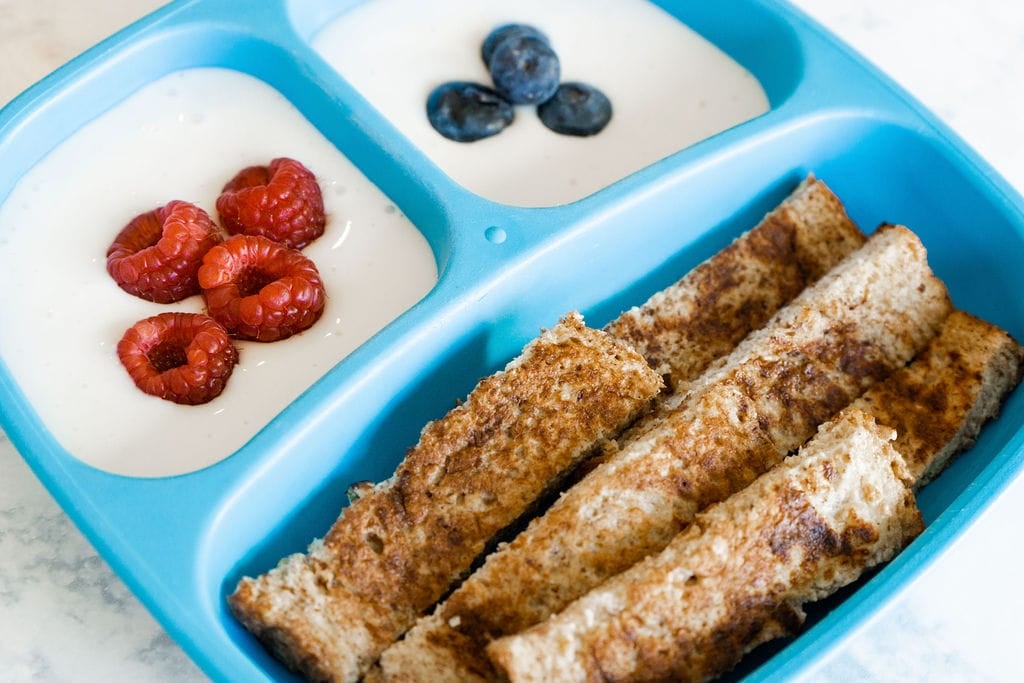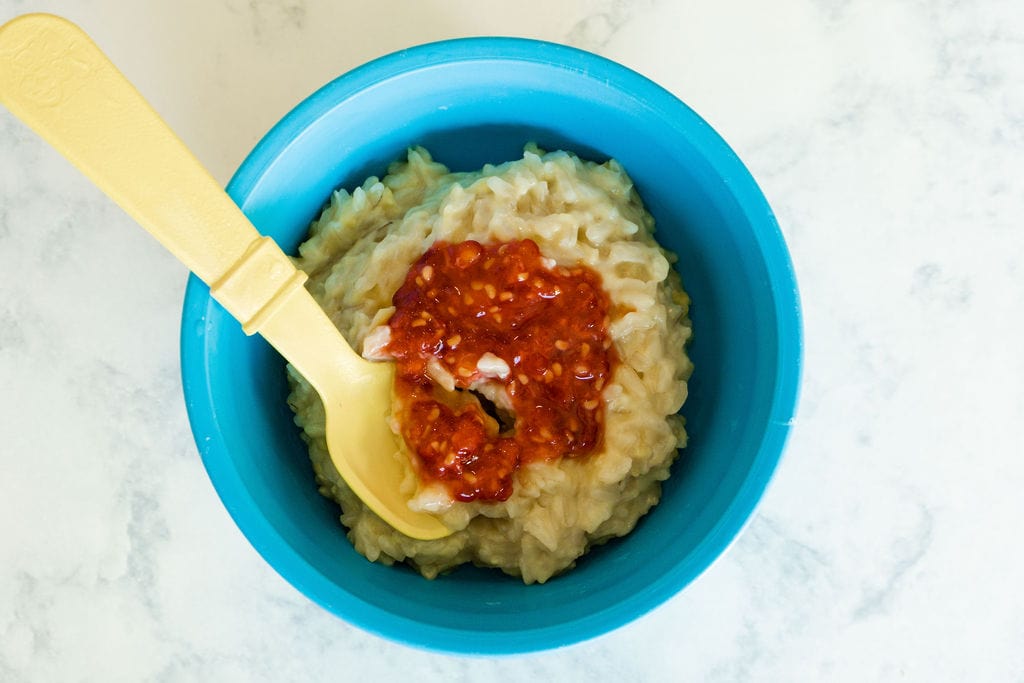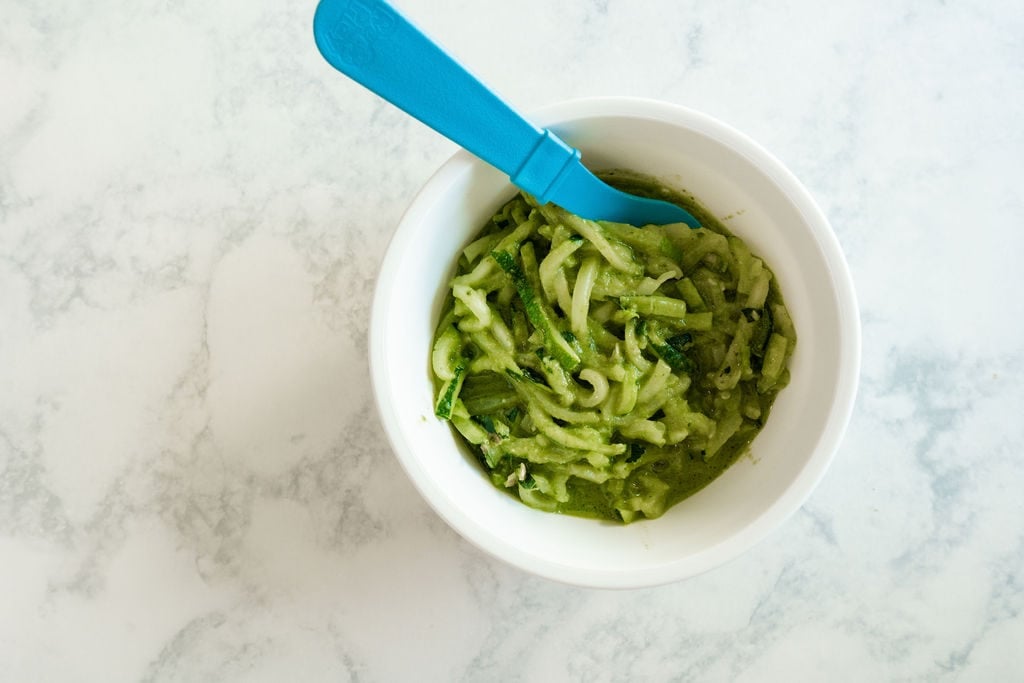
![]()

Baby-led weaning, which allows the baby to be in charge of their feeding, might be a new concept to many. In recent years, there has been a popular transition from spoon-feeding at six months to emphasizing hand-held complementary foods instead. If you’re interested in this approach, having some baby-led weaning recipes ready is helpful to allow your little one to explore. It’s important to note that safety is a priority when initiating new foods at the correct age and letting your baby lead the way.1
The baby-led weaning approach encourages your baby to explore, choose, and physically use their hands to decide what they want to eat. It emphasizes family mealtimes, building a positive relationship with food, and facilitating oral motor development. But baby-led weaning may not suit all infants and families for various reasons, so it’s your choice to decide if it fits into your lifestyle and parenting goals.
Quick Contents
So, What is Baby-Led Weaning?
Baby-led weaning is transitioning from only drinking mama’s milk or formula to adding complementary foods into the little one’s diet when they reach about six months old and letting them take the lead.3
Though research is limited on baby-led weaning, or BLW, and most evidence supporting the concept is derived from observational and anecdotal studies, there is the promise that it can help develop positive eating behaviors and food preferences. It can promote healthy body weight and adventurous eating with the right baby-led weaning recipes. Sharing mealtimes with family or friends also models to the little one what regular eating patterns look like and how to start using their oral motor skills.2
Some common risks with the BLW approach are choking hazards, inadequate calorie intake, and iron deficiency. Additionally, the types of foods you decide to introduce in your baby-led weaning recipes matter. For example, if adults at the table are eating pepperoni pizza, that food should not be introduced to a child due to the amount of salt. Your baby’s kidneys can’t handle it! Therefore, if you plan on sharing meals with your baby, be sure to limit the salt, sugar, and spice, or consider preparing a safe, separate meal for the child to eat during mealtime.2
How Can You Start BLW?
To start with BLW, determine if your baby is ready to eat solid foods. Some good indicators include:3,4
- Head and neck control and stability
- Tongue control; swallowing food rather than pushing it out of their mouth
- Sitting up with no support
- Bringing hands or objects to their mouth
- Grasping small things—like toys or food
Now that you’ve determined your baby is ready to start eating complementary foods, here are some general guidelines for introducing your little one to solid foods.
One At a Time
Start with one food at a time. The common recommendation is introducing one food besides breast milk or formula feedings. Start with one serving of that baby-led weaning recipe on the first day, introducing only one food over three days. Pay attention to your baby’s tolerance and like or dislike of the new foods.
Soft is Best
The softer the food, the better. Aim to introduce foods easily dissolved with saliva and require no chewing to decrease the risk of choking. On that note, avoid foods that are a designated choking risk, like whole grapes, large chunks of other fruit, or hot dogs.
Go Small
Remember to keep it small. Introduce small portions, encourage your little one to eat slowly, and always watch them while eating.
Location, Location, Location
The location of mealtime matters. When introducing any new food, be sure to be in a safe space, like at home or a doctor’s office (if introducing allergenic foods). Also, creating a routine to support adherence to regular eating patterns is important. That could look like a family dinner at home.
Be Persistent
Finally, stick with it! It can be difficult if your baby consistently rejects new foods; however, remember that this is the first time your little one has eaten anything thicker than breast milk or formula, so it may take introducing the food multiple times for them to eat it willingly.
Baby-Led Weaning Recipe Ideas
Breakfast
French toast fingers with maple yogurt

Makes 4 servings
Use any good, sturdy whole-grain bread for this sweet, hand-held breakfast treat. Whole-wheat bread is a fiber- and mineral-rich carbohydrate for a baby. This recipe is easily doubled so adults and older kids can join in.
Ingredients
- 1 cup plain or vanilla Greek whole-milk yogurt
- 2 tablespoons maple syrup
- 2 eggs
- ⅓ cup milk
- ½ teaspoon ground cinnamon
- 1 teaspoon vanilla extract
- 4½- to ¾-inch-thick slices whole-grain bread
- 1 tablespoon butter
Directions
- In a small bowl, mix the yogurt and maple syrup; set aside. In a medium bowl, whisk the eggs to blend. Gradually whisk in the milk, cinnamon, and vanilla. Pour the mixture into a shallow baking dish.
- Place one slice of bread in the milk mixture; turn over and let soak for 1 to 2 minutes.
- Warm a large frying pan or griddle over medium heat. Brush the pan lightly with the butter. Add the soaked bread slice (and place another slice in the mixture to soak). Cook until brown on the bottom, about 4 minutes. Turn over and cook until brown on the other side, about 4 minutes.
- Cut each slice into ½- to ¾-inch-wide strips. Serve with the maple yogurt for dipping.
To store: Leftovers can be refrigerated or frozen and reheated in the toaster.
Lunch
Coconut milk rice pudding with crushed raspberries

Makes about 2 cups
This creamy sweet treat is made with coconut milk and topped with raspberries, which add vitamin C.
Ingredients
- 1 cup water
- ⅓ cup jasmine rice
- 1½ cups light coconut milk
- 2½ tablespoons sugar
- 1 egg yolk
- 2 teaspoons cornstarch
- ⅛ teaspoon vanilla
- ¼ cup fresh or thawed frozen raspberries
Directions
- Place the water and rice in a small saucepan over medium-high heat and bring to a boil.
- Turn the heat to low, cover, and simmer until the liquid is absorbed and the rice is soft, about 20 minutes. Stir in the coconut milk and 2 tablespoons of the sugar and bring to a simmer.
- In a small bowl, stir together the egg yolk, cornstarch, vanilla, and remaining ½ tablespoon sugar into a smooth paste. Whisk a little bit of the hot milk mixture into the egg mixture until smooth, and then stir the egg mixture into the hot milk.
- Bring to a gentle boil over medium heat. Cook, stirring constantly, allowing the mixture to bubble for 2 minutes.
- Remove from the heat and spoon the mixture into bowls or ramekins. Place a piece of wax paper directly on the surface of each serving to prevent a skin from forming. Chill until cool, about 2 hours. Mash the raspberries with a fork and spoon them over the top before serving.
To store: You can refrigerate for up to two days.
Dinner
Zoodles with creamy pesto

Makes about 4 cups
Zoodles, or zucchini noodles, are a fun alternative to pasta. Gently mixed with a simple basil pesto, they make a tasty vitamin C–filled lunch or side dish that adults and older kids will like, too. A spiralizer is an inexpensive gadget that makes corkscrew-curly vegetable noodles. You can also make zucchini noodles using a vegetable peeler.
Ingredients
- 2 cups packed fresh basil leaves
- ¼ cup olive oil, plus 2 teaspoons
- 3 tablespoons water
- 2 tablespoons freshly squeezed lemon juice
- 1 small garlic clove, peeled
- Sea salt
- 3 pounds zucchini
- ¼ cup grated Parmesan cheese
Directions
- In a food processor, whirl the basil, 1/4 cup olive oil, water, lemon juice, garlic, and a pinch of salt until a smooth pesto sauce forms.
- Rinse and dry the zucchini and trim both ends. Using a spiralizer, cut the zucchini into noodles. (If you don’t have a spiral cutter, you can use a peeler to shave each zucchini into wide, thin ribbons.)
- Chop the pile of zucchini noodles a few times to have shorter strands.
- In a large nonstick frying pan over medium-high heat, warm the remaining 2 teaspoons of oil. Add the zucchini noodles and sprinkle them lightly with salt. Cook, stirring often until the noodles are bright green and softened, 5 to 6 minutes.
- Toss the noodles gently with the pesto sauce. Mound in bowls and cut into small pieces or mash to a texture your baby can handle. Top with the parmesan cheese before serving.
Tips and Tricks for Baby-Led Weaning Recipes
When preparing new foods, like fortified cereal, mix it with breast milk, formula, or water to create a consistency that is easy for your baby to swallow.
In correspondence with your pediatrician, consider introducing infants to potentially allergenic foods in conjunction with other complementary foods (including peanuts, eggs, dairy products, nuts, wheat, shellfish, and soy)—one at a time, of course. However, remember that age-appropriate introductions, such as cow’s milk, as it is recommended to introduce at 12 months of age or older.
A baby-led weaning approach may be an excellent choice for you, your family, and your little one. It is a great introductory feeding option emphasizing family mealtime, building a positive relationship with food, and facilitating oral motor development.
